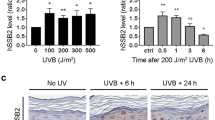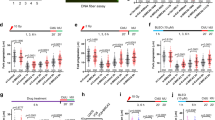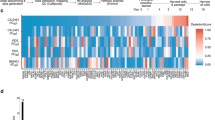Abstract
Bloom's syndrome (BS) arises through mutations in both copies of the BLM gene that encodes a RecQ 3′-5′ DNA helicase. BS patients are predisposed to developing all the cancers that affect the general population, and BS cells exhibit marked genetic instability. We showed recently that BLM protein contributes to the cellular response to ionizing radiation by acting as downstream ATM kinase effector. We now show that following UVC treatment, BLM-deficient cells exhibit a reduction in the number of replicative cells, a partial escape from the G2/M cell cycle checkpoint, and have an altered p21 response. Surprisingly, we found that hydroxyurea-treated BLM-deficient cells exhibit an intact S phase arrest, proper recovery from the S phase arrest, and intact p53 and p21 responses. We also show that the level of BLM falls sharply in response to UVC radiation. This UVC-induced reduction in BLM does not require a functional ATM gene and does not result from a subcellular compartment change. Finally, we demonstrate that exposure to UVC and hydroxyurea treatment both induce BLM phosphorylation via an ATM-independent pathway. These results are discussed in the light of their potential physiological significance with regard to the role of BLM in the cellular pathways activated by UVC radiation or HU-mediated inhibition of DNA synthesis.
This is a preview of subscription content, access via your institution
Access options
Subscribe to this journal
Receive 50 print issues and online access
$259.00 per year
only $5.18 per issue
Buy this article
- Purchase on Springer Link
- Instant access to full article PDF
Prices may be subject to local taxes which are calculated during checkout




Similar content being viewed by others
Abbreviations
- BrdU:
-
Bromodeoxyuridine
- BS:
-
Bloom's syndrome
- CFSE:
-
Carboxyfluorescein succinimidyl ester
- DSBs:
-
Double-strand breaks
- FITC:
-
Fluorescein isothiocyanate
- PI:
-
Propidium iodide
- SCE:
-
Sister chromatid exchange
References
Ababou M, Dutertre S, Lecluse Y, Onclercq R, Chatton B, Amor-Gueret M . 2000 Oncogene 19: 5955–5963
Allan LA, Fried M . 1999 Oncogene 18: 5403–5412
Ando T, Kawabe T, Ohara H, Ducommun B, Itoh M, Okamoto T . 2001 J. Biol. Chem. 14: 14–
Ashcroft M, Taya Y, Vousden KH . 2000 Mol. Cell. Biol. 20: 3224–3233
Barakat A, Ababou M, Onclercq R, Dutertre S, Chadli E, Hda N, Benslimane A, Amor-Gueret M . 2000 Hum. Mutat. 15: 584–585
Bischof O, Kim SH, Irving J, Beresten S, Ellis NA, Campisi J . 2001 J. Cell. Biol. 153: 367–380
Collister M, Lane DP, Kuehl BL . 1998 Carcinogenesis 19: 2115–2120
Dasika GK, Lin SC, Zhao S, Sung P, Tomkinson A, Lee EY . 1999 Oncogene 18: 7883–7899
Davey S, Han CS, Ramer SA, Klassen JC, Jacobson A, Eisenberger A, Hopkins KM, Lieberman HB, Freyer GA . 1998 Mol. Cell. Biol. 18: 2721–2728
Dutertre S, Ababou M, Onclercq R, Delic J, Chatton B, Jaulin C, Amor-Gueret M . 2000 Oncogene 19: 2731–2738
Ellis NA, German J . 1996 Hum. Mol. Genet. 5: 1457–1463
Ellis NA, Groden J, Ye TZ, Straughen J, Lennon DJ, Ciocci S, Proytcheva M, German J . 1995 Cell 83: 655–666
Frei C, Gasser SM . 2000 Genes Dev. 14: 81–96
German J . 1993 Medicine (Balti) 72: 393–406
Gianneli F, Benson PF, Pawsey SA, Polani PE . 1977 Nature 265: 466–469
Gottifredi V, Shieh S, Taya Y, Prives C . 2001 Proc. Natl. Acad. Sci. USA 98: 1036–1041
Gurley LR, D'Anna JA, Barham SS, Deaven LL, Tobey RA . 1978 Eur. J. Biochem. 84: 1–15
Hand R, German J . 1977 Hum. Genet. 38: 297–306
Karow JK, Chakraverty RK, Hickson ID . 1997 J. Biol. Chem. 272: 30611–30614
Karow JK, Constantinou A, Li JL, West SC, Hickson ID . 2000a Proc. Natl. Acad. Sci. USA 97: 6504–6508
Karow JK, Wu L, Hickson ID . 2000b Curr. Opin. Genet. Dev. 10: 32–38
Kim ST, Lim DS, Canman CE, Kastan MB . 1999 J. Biol. Chem. 274: 37538–37543
Kurihara T, Tatsumi K, Takahashi H, Inoue M . 1987 Mutat. Res. 183: 197–202
Levenson V, Hamlin JL . 1993 Nucleic Acids Res. 21: 3997–4004
Li L, Eng C, Desnick RJ, German J, Ellis NA . 1998 Mol. Genet. Metab. 64: 286–290
Lonn U, Lonn S, Nylen U, Winblad G, German J . 1990 Cancer Res. 50: 3141–3145
Lu X, Lane DP . 1993 Cell 75: 765–778
Mamada A, Kondo S, Satoh Y . 1989 Photodermatology 6: 124–130
Martinez-Balbas MA, Dey A, Rabindran SK, Ozato K, Wu C . 1995 Cell 83: 29–38
Muchardt C, Reyes JC, Bourachot B, Leguoy E, Yaniv M . 1996 EMBO J. 15: 3394–3402
Sauvé DM, Anderson HJ, Ray JM, James WM, Roberge M . 1999 J. Cell. Biol. 145: 225–235
Shiloh Y . 2001 Curr. Opin. Genet. Dev. 11: 71–77
Stewart E, Chapman CR, Al-Khodairy F, Carr AM, Enoch T . 1997 EMBO J. 16: 2682–2692
Taylor WR, Stark GR . 2001 Oncogene 20: 1803–1815
Tibbetts RS, Cortez D, Brumbaugh KM, Scully R, Livingston D, Elledge SJ, Abraham RT . 2000 Genes Dev. 14: 2989–3002
Wang JA, Fan S, Yuan RQ, Ma YX, Meng Q, Goldberg ID, Rosen EM . 1999 Int. J. Radiat. Biol. 75: 301–316
Wang SC, Makino K, Su LK, Pao AY, Kim JS, Hung MC . 2001 Cancer Res. 61: 2838–2842
Wang W, Seki M, Narita Y, Sonoda E, Takeda S, Yamada K, Masuko T, Katada T, Enomoto T . 2000a EMBO J. 19: 3428–3435
Wang Y, Cortez D, Yazdi P, Neff N, Elledge SJ, Qin J . 2000b Genes Dev. 14: 927–939
Wu G, Lee WH, Chen PL . 2000 J. Biol. Chem. 275: 30618–30622
Wu L, Davies SL, Levitt NC, Hickson ID . 2001 J. Biol. Chem. 276: 19375–19381
Xu X, Weaver Z, Linke SP, Li C, Gotay J, Wang XW, Harris CC, Ried T, Deng CX . 1999 Mol. Cell. 3: 389–395
Yamagata K, Kato J, Shimamoto A, Goto M, Furuichi Y, Ikeda H . 1998 Proc. Natl. Acad. Sci. USA 95: 8733–8738
Acknowledgements
We would like to thank Catherine Durieux (UMR 1598 CNRS, Villejuif) for her expert assistance in FACS analysis. We also thank Christian Jaulin (CNRS UPR 1142, IGH, Montpellier) for invaluable stimulating discussions and critical reading of the manuscript. This work was supported by funds and/or fellowships from the Centre National de la Recherche Scientifique, the Association pour la Recherche sur le Cancer (ARC 9660 and 5419, to Mounira Amor-Guéret), the Fondation pour la Recherche Médicale, the Fondation de France and the Ligue Nationale contre le Cancer (Comité de Val de Marne). Mouna Ababou is a recipient of a fellowship from the Ligue Nationale contre le Cancer (Comité de la Haute-Marne) and Virginie Dumaire is a recipient of a fellowship from the Ecole Nationale Supérieure de Cachan.
Author information
Authors and Affiliations
Corresponding author
Rights and permissions
About this article
Cite this article
Ababou, M., Dumaire, V., Lécluse, Y. et al. Bloom's syndrome protein response to ultraviolet-C radiation and hydroxyurea-mediated DNA synthesis inhibition. Oncogene 21, 2079–2088 (2002). https://doi.org/10.1038/sj.onc.1205246
Received:
Revised:
Accepted:
Published:
Issue Date:
DOI: https://doi.org/10.1038/sj.onc.1205246
Keywords
This article is cited by
-
RecQ helicases; at the crossroad of genome replication, repair, and recombination
Molecular Biology Reports (2012)
-
RecQ helicases: guardian angels of the DNA replication fork
Chromosoma (2008)
-
BLM and the FANC proteins collaborate in a common pathway in response to stalled replication forks
The EMBO Journal (2004)
-
Werner's syndrome protein is phosphorylated in an ATR/ATM-dependent manner following replication arrest and DNA damage induced during the S phase of the cell cycle
Oncogene (2003)
-
RecQ family helicases: roles as tumor suppressor proteins
Oncogene (2002)



